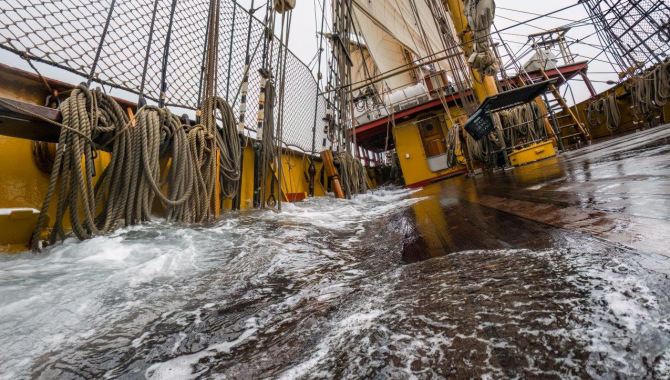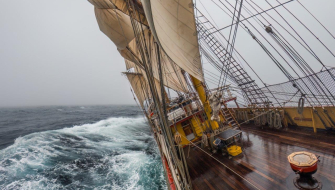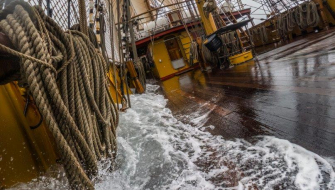Scotia Sea

On our way to Antarctica. North-northwesterlies allow us to gain some westing. Icebergs, growlers, bergy bits in the foggy and wet weather.
Wet, cold, and we can add foggy, windy and rough too. The journey from South Georgia to Antarctica. Not an easy crossing along the dreadful Scotia Sea. Today we made good progress of 147nm in a straight line, 153 actually sailed during the last 24h. But with the changing winds, tomorrow sure will be different.
We sail the very same difficult stretch of the Southern Ocean that 108 years ago saw a 23-foot-long open boat manned by six men, sailing to save their lives and the lives of the rest of the Endurance crew. For 16 days they braved these waters, just making it in the opposite course than the Europa tries to steer these days.
They managed to sail the nowadays most famous sloop across these rough seas of the renowned latitudes called the Furious 50s.
In a quiet, countrified part of south London, sheltering in the cloister of a famous school of ancient lineage, resting on a bed of grey South Atlantic boulders, is a small boat, painted white and ketch-rigged, with all sails set.
Undoubtedly the most famous small boat in existence, she has been displayed at the school, off and on, since 1924.

…
In 1916, this small boat played a vital part in an incredible journey which saved the lives of 28 shipwrecked men. She epitomises, perhaps better than any other existing artefact, the extraordinary qualities of the man who led the expedition and masterminded the rescue.
The man was Sir Ernest Shackleton, the boat is the James Caird, and the school, Shackleton’s alma mater, Dulwich College. The date of the voyage was April to May 1916.
Harding McGregor Dunnet. “Shackleton’s Boat. The Story of the James Caird”

It was Norwegian whalers who took what was left of her from the rocky and icy beach of King Haakon Bay in South Georgia, where she lay after her epic sailing from Elephant Island, and shipped her to England in 1919.
An oceanic crossing that doesn’t seem to have changed much in its idiosyncrasy since then. As Captain Worsley, in command of the Endurance and then main navigator of the James Caird, said: “Since leaving Elephant Island I had only been able to get the sun four times, two of those being more snaps or guesses through slight rifts in the clouds.
The conditions for observing the sun were most unfavourable. It was misty, the boat was jumping like a flea, shipping seas fore and aft.”
Conditions that for us translated today to north-northwesterly 25 to 30kn winds, on which we steer close-hauled on a good 250º to 270º course towards Elephant Island. Further south, the impenetrable blanket of the Weddell Sea ice. This season extending quite a lot northwards, even still embedding completely the South Orkney Islands.
Stronger gusts make us first douse and furl the royals in the early morning. And later on, top gallants, middle staysails, and outer jib have to be quickly pulled down and stowed away.
Quite fierce winds as a combination of the high latitude where we sail, and the compression zone where we find ourselves between a high pressure to our northeast and an incoming low sweeping, as they usually do, around Antarctica from west to east.
The foggy situation asks for having to keep a good eye on the occasional bergy bit, growler, or field of small ice pieces we come across now and then. They are mostly debris of calvings, drifting at the lee side of several icebergs, some of them between 3 to 5nm long and 2nm wide.
Lookouts have to keep running through the whole day and especially the dark night with reduced visibility.